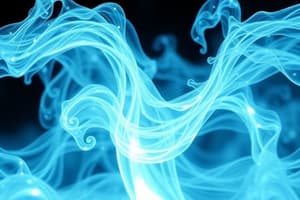Podcast
Questions and Answers
What is the ideal gas law equation?
What is the ideal gas law equation?
PV = nRT
What is the value of R in the ideal gas law?
What is the value of R in the ideal gas law?
0.08205 liter atm/mole K
What happens to gas particles when they lose kinetic energy?
What happens to gas particles when they lose kinetic energy?
They move slower and can transition to liquid state.
What is critical temperature?
What is critical temperature?
What is critical pressure?
What is critical pressure?
The critical temperature of water is 374 C.
The critical temperature of water is 374 C.
Which of the following substances must be cooled to a low temperature before it can be liquefied?
Which of the following substances must be cooled to a low temperature before it can be liquefied?
The equation for average kinetic energy (E) of gas particles is ____.
The equation for average kinetic energy (E) of gas particles is ____.
What are aerosols?
What are aerosols?
What types of propellants are commonly used in aerosols?
What types of propellants are commonly used in aerosols?
Flashcards are hidden until you start studying
Study Notes
Ideal Gas Law
- The ideal gas law is a fundamental equation in chemistry that relates the pressure (P), volume (V), number of moles (n), and temperature (T) of an ideal gas.
- The equation is: PV = nRT, where R is the ideal gas constant (0.08205 L atm/mol K).
- Ideal gases are theoretical gases whose molecules have negligible volume and do not interact with each other.
Gas Particles
- Gas particles have kinetic energy and exhibit continuous random motion.
- The average kinetic energy of gas molecules is directly proportional to the absolute temperature of the gas.
- The formula for kinetic energy is E = (3/2)RT
Real Gases
- Real gases have molecules of a finite volume and interact with each other.
- This can affect the pressure and volume of the gas.
- The van der Waals equation is used to account for these interactions.
- The van der Waals equation: (P + a/V^2)(V - b) = RT.
- "a" represents the intermolecular attraction and "b" represents the volume of the molecules.
Liquid State
- Liquids are denser than gases and occupy a definite volume.
- They form when a gas is cooled and loses kinetic energy, and the molecules are brought within the range of attractive forces.
- The transition from a gas to a liquid depends on temperature and pressure.
Critical Temperature & Pressure
- The critical temperature is the temperature above which a gas cannot be liquefied, regardless of the pressure applied.
- The critical pressure is the pressure required to liquefy a gas at its critical temperature.
- The critical temperature is a measure of the attractive forces between molecules.
Methods for Liquefying Gases
- Cooling: Subjecting a gas to intense cold (by using freezing mixtures) can cause it to liquefy.
- Adiabatic Expansion: Expansion of a gas into a vacuum causes a decrease in temperature due to the work of expansion.
- Joule-Thomson Effect: The expansion of highly compressed gas into a region of low pressure causes cooling.
Pharmaceutical Applications of Liquified Gases
- Aerosols: Aerosols are dosage forms where a drug is dissolved or dispersed in a liquefied gas (propellant).
- These are stored at high pressure in a closed container to maintain the liquid state.
- When the valve is released, the pressure drops, causing the liquid to vaporize and spray the drug particles.
- Common propellants include chlorofluorocarbons (CFCs), hydrofluorocarbons (HFCs), nitrogen, and carbon dioxide.
Aerosol Containers
- The pressure within the container ranges from 1 to 6 atm at room temperature.
- The container holds both gaseous and liquid phases at room temperature.
- The container can be filled by cooling the propellant and drug to a low temperature or by forcing the required amount of propellant into the container with the drug already inside.
Studying That Suits You
Use AI to generate personalized quizzes and flashcards to suit your learning preferences.



